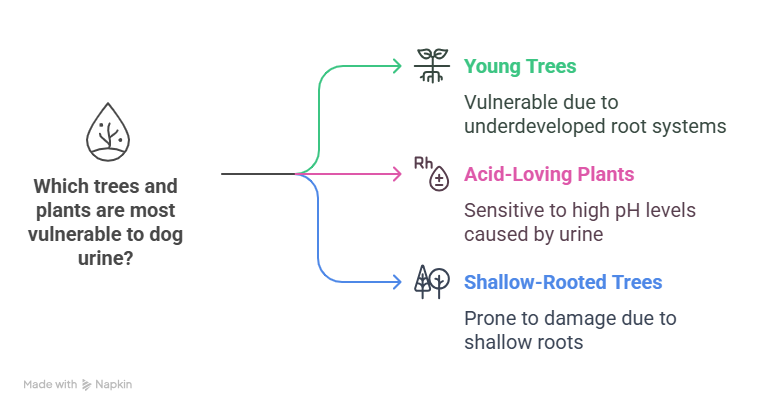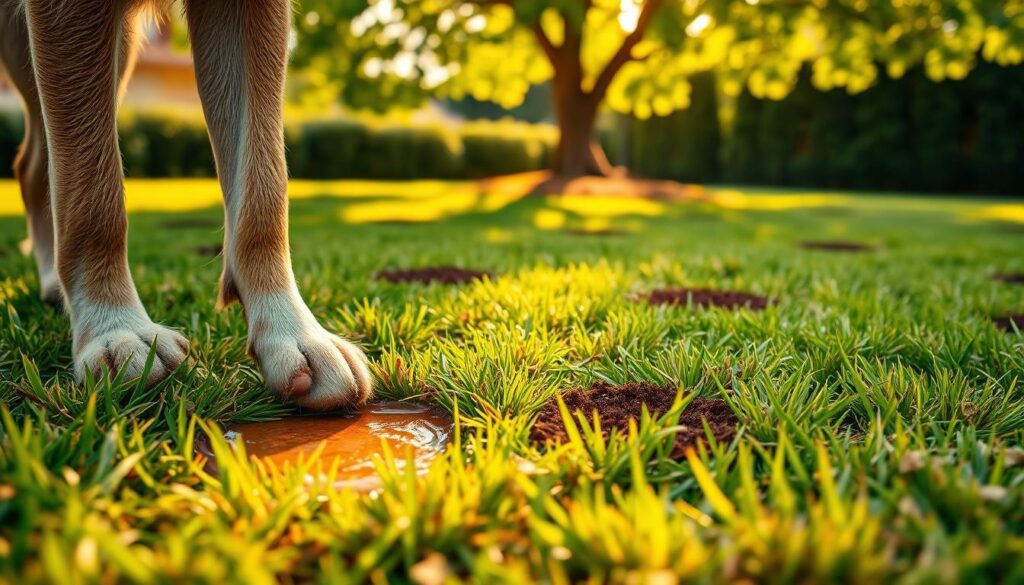As a dog owner, you love spending time outdoors with your furry friend. However, you may have noticed that your yard is starting to show signs of damage, particularly around the trees.
Dog urine can be particularly harmful to vegetation, causing unsightly burn spots and potentially even killing trees. The high concentration of nitrogen in dog urine can be toxic to plants, leading to damage and discoloration.
Fortunately, there are steps you can take to mitigate the effects of dog urine on your yard. In this article, we’ll explore the science behind dog urine damage and provide practical tips to help you save your yard.
The Impact of Dog Urine on Trees and Plants
Dog urine can have a significant impact on the health of trees and plants in your yard. The issue is primarily related to the high nitrogen content found in dog urine.
Understanding Nitrogen Concentration in Dog Urine
Dog urine contains a high concentration of nitrogen, which can be detrimental to plants when it accumulates in the soil. While nitrogen is an essential nutrient for plant growth, excessive amounts can cause damage.
The nitrogen in dog urine is often in the form of urea, which converts to ammonia and then to nitrate in the soil. This process can lead to an overabundance of nitrogen, potentially burning plant roots and causing other problems.
Short-term vs. Long-term Damage to Trees
The impact of dog urine on trees can vary depending on whether the exposure is short-term or long-term. Short-term exposure might result in temporary damage, such as yellowing or browning of leaves, which may recover if the urine exposure stops.
Long-term exposure, however, can lead to more severe and lasting damage, including stunted growth, chronic leaf scorch, or even tree death in extreme cases.
Which Trees and Plants Are Most Vulnerable
Some trees and plants are more susceptible to damage from dog urine than others. Generally, plants that are sensitive to high nitrogen levels or have shallow root systems are more vulnerable.
- Young or newly planted trees are particularly at risk due to their underdeveloped root systems.
- Certain species like azaleas, rhododendrons, and other acid-loving plants can be sensitive to the high pH levels that urine can cause in the soil.
- Trees with shallow roots, such as maples and willows, are also more prone to damage.

Will Dog Pee Kill a Tree? Understanding the Science
Understanding the science behind dog urine damage is crucial for mitigating its effects on trees. Dog urine contains high levels of nitrogen, which, while essential for plant growth in moderate amounts, can be detrimental in excessive concentrations.
The Chemistry Behind Urine Damage
Dog urine is particularly harmful due to its high nitrogen content. When dog urine comes into contact with the soil, it can cause an overabundance of nitrogen, leading to fertilization burn, where the roots of the tree are damaged due to the excessive nutrient levels. This can result in the tree’s inability to absorb water and nutrients properly, leading to decline and potentially death.
The chemistry behind urine damage involves not just nitrogen but also other compounds that can affect soil pH and microbial activity. Understanding these chemical processes is key to preventing damage from dog pee on trees.
Visible Signs Your Tree Is Suffering
Identifying the visible signs of urine damage is crucial for taking timely action. Common signs include:
- Yellowing or browning of leaves
- Dead branches or sections of the tree
- Reduced growth or stunted appearance
These symptoms can indicate that a tree is suffering from the effects of dog urine. Early detection allows for intervention to mitigate further damage and protect tree health and pet waste.
Environmental Factors That Worsen Damage
Several environmental factors can exacerbate the damage caused by dog urine. These include:
- Soil Quality: Poor soil quality can reduce a tree’s ability to recover from urine damage.
- Drainage: Areas with poor drainage can lead to concentrated urine patches, increasing the damage.
- Weather Conditions: Drought or extreme weather conditions can stress trees, making them more susceptible to urine damage.
By understanding these factors and the chemistry behind urine damage, dog owners can take proactive steps to protect their trees. This includes training dogs to avoid certain areas, using soil treatments to neutralize the urine, and implementing landscaping strategies that mitigate the impact of dog waste on tree health.
Effective Solutions to Protect Your Trees and Yard
By adopting a combination of training strategies and yard care techniques, dog owners can protect their trees. Dog urine contains high levels of nitrogen, which can be detrimental to trees and plants. However, with the right approaches, it’s possible to mitigate this damage and maintain a healthy yard.
Training Strategies for Your Dog
Training your dog to urinate in a specific area can significantly reduce the damage to your trees. One effective method is to designate a particular spot in your yard where you encourage your dog to urinate. This can be achieved by consistently taking your dog to the same spot and rewarding them when they urinate there.
Tips for Training:
- Choose a spot away from trees and plants.
- Use positive reinforcement when your dog urinates in the designated area.
- Be consistent in taking your dog to the designated spot.
Physical Barriers and Tree Guards
For trees that are particularly vulnerable or valuable, consider using physical barriers or tree guards. These can prevent dogs from accessing the trees and reduce urine damage.

Tree guards come in various forms, including plastic or metal mesh guards that surround the tree trunk. These guards not only protect against urine but also against other potential damages such as rubbing or chewing.
Soil Treatments and Natural Neutralizers
Applying soil treatments and natural neutralizers can help counteract the effects of dog urine on trees. One common method is to water the affected area thoroughly to dilute the nitrogen concentration.
Natural Neutralizers:
- Gypsum: Helps to neutralize soil pH and reduce nitrogen impact.
- Compost: Rich in beneficial microbes that can help break down harmful nitrogen compounds.
Landscaping Tips for a Dog-Friendly Yard
Creating a dog-friendly yard involves selecting plants that are more resistant to dog urine and designing your landscape in a way that minimizes damage. Consider using plants that are known to be more tolerant of nitrogen-rich soil.
Dog-Friendly Plants: Incorporate plants like lavender, rosemary, or yucca, which are known for their resilience against dog urine.
Conclusion
Protecting your trees from dog urine damage requires a combination of understanding the issue, implementing effective training strategies, and utilizing the right tree care techniques. By recognizing the impact of canine urine on your trees and taking proactive steps, you can enjoy a healthy and thriving outdoor space while ensuring the well-being of your pets.
Effective tree care and canine urine management go hand-in-hand. By incorporating strategies such as training your dog to avoid certain areas, using physical barriers, and applying soil treatments, you can significantly reduce the risk of damage to your trees. This holistic approach to safeguarding trees from pet waste not only preserves the beauty of your yard but also contributes to a sustainable environment.
By adopting these measures, dog owners can create a harmonious balance between enjoying their outdoor spaces with their pets and maintaining the health and integrity of their trees. This approach to tree care and canine urine management is essential for a lush, thriving yard that benefits both your family and your pets.
FAQ
Will dog pee kill a tree?
Dog urine can potentially harm or kill a tree if it contains high concentrations of nitrogen and is repeatedly deposited in the same area. However, the extent of the damage depends on various factors, including the tree species, soil quality, and drainage.
How does dog urine affect trees and plants?
Dog urine contains high levels of nitrogen, which can be beneficial to plants in small amounts but detrimental in large quantities. Excessive nitrogen can cause fertilizer burn, damaging roots and leaves, and altering soil chemistry.
Which trees are most vulnerable to dog urine damage?
Trees with shallow root systems, such as maples and oaks, are more susceptible to dog urine damage. Additionally, young or newly planted trees may be more vulnerable due to their underdeveloped root systems.
Can I prevent dog urine damage to my trees?
Yes, there are several ways to prevent or mitigate dog urine damage, including training your dog to urinate in a specific area, using physical barriers or tree guards, and applying soil treatments or natural neutralizers to counteract the nitrogen in dog urine.
What are some effective soil treatments for dog urine damage?
Soil treatments like gypsum, dolomitic limestone, or compost tea can help neutralize the nitrogen in dog urine and restore soil balance. You can also use products specifically designed to mitigate dog urine damage, such as those containing beneficial microbes.
How can I create a dog-friendly yard that protects my trees?
To create a dog-friendly yard, consider incorporating landscaping features like dog urine-friendly plants, designated dog areas, and efficient drainage systems. You can also use mulch or other materials to help neutralize dog urine and reduce its impact on trees.
Can dog urine damage be reversed?
In some cases, dog urine damage can be reversed by removing the affected soil, aerating the soil, or applying treatments to restore soil health. However, severe or prolonged damage may be irreversible, and the tree may need to be removed.
How can I reduce the nitrogen concentration in my dog’s urine?
Feeding your dog a balanced diet, ensuring adequate hydration, and considering supplements like cranberry or omega-3 fatty acids may help reduce the nitrogen concentration in their urine.






2 thoughts on “Will Dog Pee Kill a Tree? Tips to Save Your Yard”